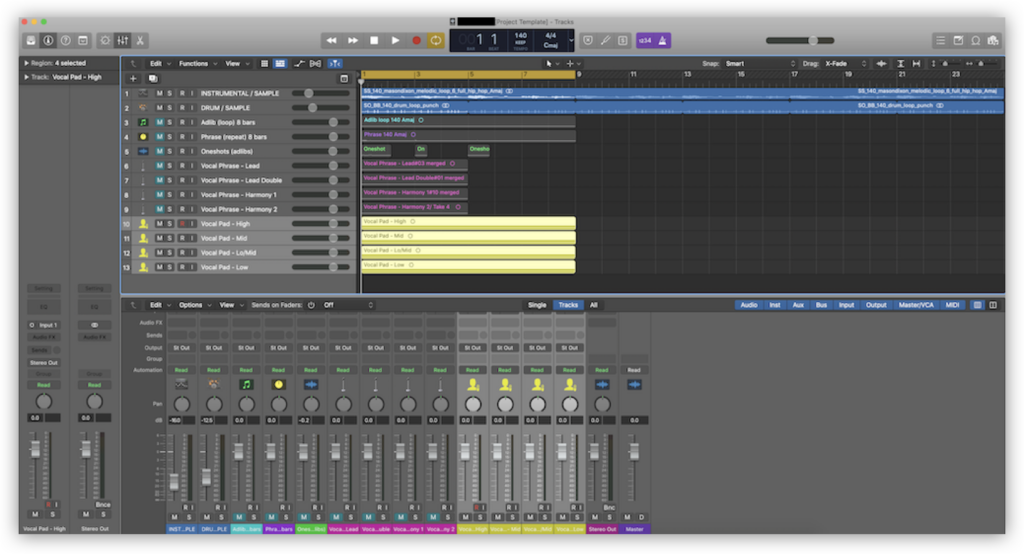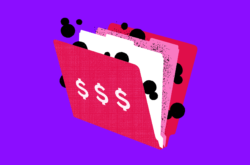Illustration: Franco Égalité
So you want to start a sample label?
Here’s a behind-the-scenes look at what running your own sample label entails.
The prospect of starting a sample label is an exciting one, but there are many intricacies that go unnoticed if you’re not involved with day-to-day operations. To build a holistic picture, we spoke with four sample label leaders from the Splice community to learn the ins and outs of running a sample label business.
Identify your purpose and goals
Although the sample world offers great earning potential, doing anything solely for money in the music industry can lead to rapid burnout and a less than fulfilling experience. It’s crucial to have a purpose, to know why you’re starting a sample label. Everyone’s purpose will look different.
Sometimes, it’s a matter of filling a need or gap in the market. Kate Wild of 91Vocals has a few guiding motivators. As a session vocalist, she saw a lack of quality in songwriting and vocal recordings in the sample community. On a personal level, she wanted to break out from the vocalist’s silo and collaborate with others. She also liked the idea of having control of what she created and the ability to spend more time producing – to transition from hobby to career.
In addition to seeing a gap in the market for real, legal, and authentic soul instrumentals and vocals, Wes Pendleton and the other Soul Surplus founders spotted an opportunity to get a foot in the door at major labels. He said, “It only takes one big producer to use your sounds, see your name, and want to work together on custom, royalty-bearing collaborations. These opportunities could lead to label recognition as a co-writer or co-producer, and may open doors to a publishing deal or working with other artists on that label.”
Wild added, “[Having a label] puts you in rooms you haven’t walked into yet. Your reputation precedes you a bit.” An artist or producer is much more likely to respond to a cold email from someone whose sounds they’ve used in their tracks.
Sean Davis of AudeoBox offered a different perspective. He said, “It allows you to put your spin on something without it taking over your life. By collaborating with others as a label, you can explore different genres and styles and create new work without diluting your artistic vision or confusing your listeners.”
Your specific purpose will drive your goals, which will inform each of your strategies. A guiding principle will keep you on a clear path and help you make important decisions along the way.
Define your unique value proposition (what you’re offering)
While your guiding purpose is an internal compass, your unique value proposition (a niche or style) is what makes you stand out to external audiences. It’s your competitive edge, whether you’re offering a unique spin on what’s out there or introducing something completely new.
Kate Wild’s unique value was clear out of the gate: to solve the lack of high-quality vocal samples available. As an expert in that area with recording experience to back it up, she partnered with Capsun of Capsun ProAudio, who offered label experience to bring her vision to life. She suggests, “Focus on the things you’re best at. Sometimes that in itself becomes your niche or defines your brand.”
Wes Pendleton says focusing on a niche or a specific genre keeps you top of mind when people need that specific sound. He added, “Because we specialize in soul, people tend to come to us first. That gives you an advantage. When someone is thinking about that particular sound, they know they can come to us and get quality every time.” By becoming a leader in such a highly-demanded genre, Soul Surplus has found an audience beyond artists and producers among ad agencies, podcast producers, and film/TV production companies.
Focusing on a genre or niche makes your brand more discoverable if someone searches for a specific term like “soul samples.”
AudeoBox offers a slightly broader variety of musical genres. They set themselves apart with high-quality trap and future R&B samples and a clear artistic vision that’s uniquely them. We’ll dive deeper into branding below, but AudeoBox’s focus on storytelling plays a large role in their competitive edge. Each sample pack has custom animated art that illustrates what the pack sounds like, appealing to those who are visually inclined.
Davis of AudeoBox found that crafting niche packs under a broader label is an effective way to garner attention. They did this with their ‘MCMLXXXV (1985)’ pack, which focuses on the synthwave sounds of the mid-80s. They’ve become experts in spotting trends. They knew Stranger Things was returning last year and Davis could hear an uprising of the subgenre in the indiesphere. He pays attention to trends and gets ahead of them.
He suggests listening to what your competitors and peers are releasing. Most importantly, listen to the music in the genre you’re making and don’t rip off songs – more on that below. To build a sustainable business, follow what you enjoy and are skilled in, rather than chasing trends or the hot genre of the moment.
Choose a business model for your sample label
There are four main broad types of business models for a sample label: royalty-free, royalty-bearing, small/boutique, or a large marketplace-style company. Your business may be a combination of two of the four.
In a royalty-free model, sales royalties (a percentage of profits from the sale or download of a sound or pack) are distributed to producers and artists. They don’t receive publishing royalties from the resulting projects post-purchase. In a royalty-bearing model, the rights holders receive publishing royalties on the publishing and master sides. In this case, the samples need to be cleared before being licensed for commercial use in sync, for example.
In terms of your business structure, you have nearly endless options. You can distribute your samples through a marketplace like Splice or lone-wolf it and focus on building an independent brand through ads, partnerships, collaborations, social media, and other marketing channels. Or, you can do both. The structure of your business will depend on how much capital you have and the market during that time, as well as your niche, purpose, and goals.
Know what’s legal
According to many instruments’ terms and conditions, you cannot use those tools to create samples for selling. This comes as a big surprise to many, often when it’s too late.
With Native Instruments, for example, it’s “strictly prohibited to use single, combined or modified sounds from Native Instruments to create sound libraries, loop libraries, sample CDs or similar products, as the license granted is strictly limited to one person only – any trading, lending, renting, re-issuing, redistribution or re-sale of sounds is not permitted under any circumstances.”
It is also illegal to download a sample from a marketplace like Splice, change it a little, and then resell it as a stand-alone one-shot or loop.
Kam Shariff of Capsun ProAudio and X10 says that if you’re building a library, you have to craft 100% original sounds. Read the terms and conditions of every instrument you’re using and ensure you have full rights to sell the sounds you make. Understand what you can and cannot use to create samples.
He added, “producers aren’t necessarily sound designers. In creating our trap sounds, we need sound designers. People who will craft original sounds from instruments that are legal to use in sample creation. As a label leader, you have to have an ear for that.”
Davis added, “I think it’s going to come to a head with the way people are making sounds. The smarter AI gets, the better it will be at detecting rip-offs and certain instruments/plugins. Sometimes I hear something and think, there’s no way it was made from scratch. If it was, it was close to infringing on someone’s rights.”
This is why originality is so important. Create new, raw sounds or know exactly where everything you’re using came from. If you can afford it, consider getting a lawyer or legal advising.
Get your finances in order and know how much capital you need
Before you get too far into your business plan, know how much money you need to launch. When it comes to making your first packs, Wild suggests asking yourself:
- How much do you need to spend on the most basic gear setup?
- How many packs do you want?
- How many people do you need to start recording?
- Do you need to rent or buy gear?
- What kind of pack art will you use? Where will it come from?
- What admin costs will add up: email addresses, websites, hosting, file management, etc.?
Make a list of every small thing you can think of. Research how much each item will cost with fair pay, as you have a reputation to build and relationships to develop. Kate added that if you’re bartering or trading with a vendor, be sure to offer equal value.
Capital needed will depend on what type of samples you’re crafting. If it’s as simple as only vocals or drums, your overhead will be low. If you’re creating orchestral sounds with groups of musicians, it’ll be much higher.
Think long-term when planning your buyouts and royalty splits with artists and producers.
In the beginning, 91Vocals were providing buyouts with singers and producers rather than offering sales royalties. Wild said, “The reason wasn’t that we didn’t want to share the growth and money; it was a matter of cash flow. We couldn’t afford to split what we didn’t know we’d earn. We didn’t know what our sales would be, so we were conservative with our spend while still being fair to the artists. Now we’re at a position where our name is growing, we have reliable and professional musicians and producers, and enough packs out to offer fair, royalty-bearing deals for artists and producers.”
You most likely won’t make money right away. It could take a month or a couple of years. Know how you’ll support the label until it can support itself – through a part-time job, side hustle, financial backing, etc.
When planning, Davis suggests having four completed sample packs ready before launch, but not a series. If you launch with a series and the first one flops, you’ve wasted money. He added that those first four should at least break even and pay for themselves. If they don’t, you’ve spent too much money. Your initial packs don’t need to be huge. Focus on establishing a voice for yourself. Your smaller packs costs can be recouped much faster.
As you’re saving or raising capital, be sure to have a cushion for emergencies. Wild said, “You’ll make mistakes; make sure you can afford them.”
While you’re thinking through finances, be thinking about strategy as well. Where will you source each item you need? How will you market them? Take a holistic approach to planning.
Find a mentor
Find a mentor who’ll help you spot any potential oversights. Learn their process, mistakes, lessons, what they did right, etc. Learn what gear they use and don’t use. A mentor will help you spot any red flags when engaging in partnerships and other business deals. A good mentor will show you the ropes and provide priceless support.
Build a brand for your sample label
This could certainly be its own article. Your brand is your visual identity but also so much more. It’s your messaging, reputation, how you conduct business, your vision, and your perspective.
Do your research. If you have a company name in mind, see if it’s already taken or has any other meanings in other cultures or languages. Be sure you’re not appropriating another culture. You’ll need a company name, email address, URL, and at least a basic landing page. Make sure all your social media handles are available and the same across channels.
When you’re thinking about visuals, look at the landscape and what labels are doing. What do you like and not like about their fonts, colors, styles, logos, messaging, etc.? You might not have a full brand identity developed for your first few packs. Start developing an idea of what you want if your first packs earn enough revenue to reinvest in your brand.
Davis says, “If you don’t have a perspective, you’re going to get lost.” That’s why AudeoBox has a storyline for every pack. Each hand-drawn cover is designed specifically for that pack and story. It’s fully rendered to also be animated so they can visually express what a pack sounds like.
Focus on your reputation by paying all of your collaborators fairly and on time. Davis suggests giving them credit even in the file name. He added, “If they want to be, they should be celebrated as much as the label; the creator also put in the work.” Maintaining a strong reputation also means keeping your distributors in the loop as things change or if something goes wrong.
Create a go-to-market strategy
As with any business, you’ll need a marketing plan and go-to-market strategy. Pendleton says some labels don’t distribute publicly, but rather go straight to producers. Even so, you still need a plan for developing those partnerships and communicating the value you’re offering them.
Know your timelines. Most packs take four to eight weeks to develop; plan your distribution strategy around that. Think like a record label in terms of how you’ll announce and preview each one, as well as how you stagger releases. Give each plenty of breathing room so they see the recognition they deserve.
For marketing, you’ll need the basics before launch: a landing page and social media accounts on the channels geared toward audio like Instagram and YouTube. What type of videos will you make? Animated pack art? Behind-the-scenes peeks at making the pack? A full-blown music video?
Once events are a thing again, plan an event strategy for relationship building. Plan to go to conferences like NAMM or ADE where you can hand out USBs of samples and secure meetings.
Get organized and develop a system and process
A lot of running a label is administrative work. If you’re in it for the glamour, consider a different career. That said, there are many opportunities for streamlining the process for yourself and your artists.
Guidelines and templates
You’ll be working closely with artists and producers. For consistently high-quality samples, streamline the administrative side of the process so they can focus on the creative side.
For 91Vocals, Wild creates crystal clear guidelines that rely heavily on audio examples to demonstrate the style or type of sample she’s looking for. That way, there aren’t large bodies of text for artists to go through (or ignore). These guidelines outline the details of how many samples she wants for each style, how to name them, etc.
She goes a step further and creates templates in Pro Tools and Logic so artists can upload their session straight into it. When they deliver it back, it looks exactly how she needs it to look with her naming system, color coding, labels, etc. These templates indicate exactly how much of each category she needs – “20 sounds of this, 30 of that” – rather than “give me 200 sounds in this style.” She added, “Like any artist, they want visual details; they want direction.”

An example of a 91Vocals sample pack template in Logic Pro X
Set up a QA process
At AudeoBox, Davis makes a brief detailing what they want along with separate folders indicating how much of each thing they want. They then break the details down into a spreadsheet template and go through each sound to QA it. They’re looking for quality and red flags that might suggest a sample was created illegally.
Davis said, “We don’t want to see just 30 sounds for a particular folder, we want the 30 best sounds for it. We’re less particular about hitting that number, though. It’s better to have the right things than to have the most things.”
Measuring the success of your sample label
There are traditional, quantitative indicators of successful growth from your initial packs: sales, website visits, and brand growth via social media followers. Davis says he looks for the qualitative data as well. He wants to know what conversations are happening about their brand and packs.
He suggests looking at message boards to see if your community or another one is talking about it. If artists of a different genre than you designed the pack for are interested, that’s intel to help you better learn who your audience is.
He also looks to see if their packs were leaked to torrent sites to get it taken down, of course, but to also measure interest. Finally, if producers, artists, or manufacturers are excited to work with you again, that’s a good sign.
Final thoughts
Each of the above sections could have been expanded into their own articles or even books. If you’re serious about starting a label, talk to folks in the industry to gain a thorough understanding of what you need to launch. Talk to lawyers about the legalities. Do your research and start thinking about the unique perspective you have to offer to the sample world.
Have more questions on starting a sample label? Leave them in the comments below.
Explore royalty-free sounds from leading artists, producers, and sound designers:
July 14, 2020



